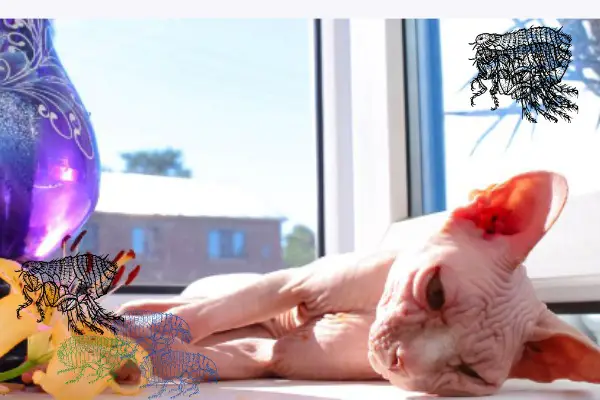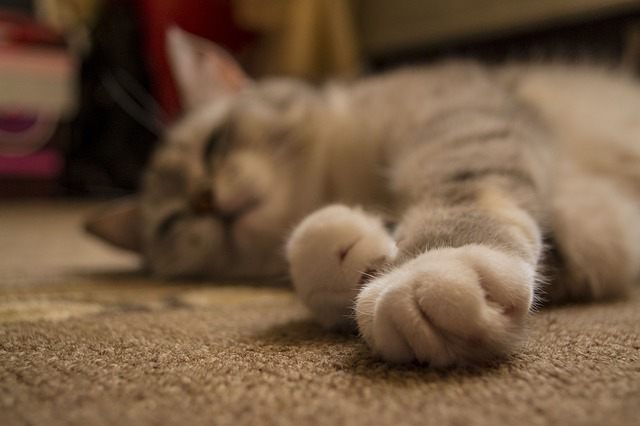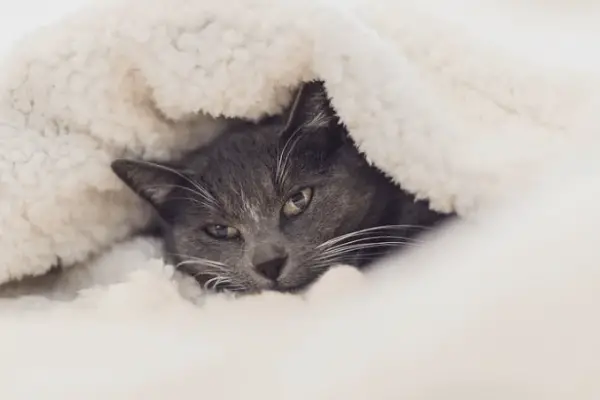How Do Cats Get Bacterial Infections [12 Hints]
![How Do Cats Get Bacterial Infections [12 Hints] How Do Cats Get Bacterial Infections](https://petcreeks.com/wp-content/uploads/2021/03/How-Do-Cats-Get-Bacterial-Infections.jpg)
How do cats get bacterial infections? Let’s find out together…
In this blog post, we’ll be looking at the various ways that cats can contract bacterial infections and some ways to keep our beloved pets healthy and happy.
There are many ways cats can get a bacterial infection, however, most of these ways are influenced by the owner.
Let’s get started…
Before then, let’s quickly look at signs of bacterial infections in cats.
Signs of bacterial infections in cats
Here are some possible signs you might see:
- Fever
- Loss of appetite
- Lethargy or weakness
- Vomiting or diarrhea
- Increased thirst
- Difficulty breathing
- Discharge from the eyes or nose
- Skin rash or inflammation
- Visible wounds or abscesses
Learn more about the signs of bacterial infections in cats.
Let’s continue…
How Do Cats Get Bacterial Infections
![How Do Cats Get Bacterial Infections [12 Hints] 14 ways a cat can get bacterial infections](https://petcreeks.com/wp-content/uploads/2021/03/14-ways-a-cat-can-get-bacterial-infections.jpg)
Here are the most common ways a cat can get bacterial infections:
1. Eating an infected mouse
Cats can get bacteria infections through the infected mouse either by eating the mouse or by going to the mouse nest or path.
Mice are known to be heavy carriers of bacteria and the most funny part is these bacteria do not affect these mice.
Make sure you keep your cat away from mice as far as you can and give your cats immune boosters just in case they go after mice when you are not looking.
2. Eating Bacteria Contaminated Food
Feeding your cat with already contaminated food is an easy way for bacterial pathogens to be transferred to cats.
There are many unhealthy practices that cat owners carry out that can cause cross contamination which you must avoid.
Living your cat food open in an unhealthy or unclean environment is a bad practice because the open food can get infected.
Always keep your cat food safe and be sure to never feed your cat with contaminated food.
3. Other Infected Pets
Allowing your cat to come in contact with any infected pets, be it other cats, dogs or birds is one of the simple ways cats get bacteria infection.
Cats love to wander around a lot and could meet other infected pets, the infected pet has a high chance of transferring bacterial infections to a free cat.
A good practice is that knowing your cat is infected with a bacteria and not allowing your cat to visit other cats during this period.
Bacterial pathogens are easily transferred, therefore, make sure you keep your cat away from infected pets be it other cats or dogs.
4. Poor hygienic practices
Poor hygienic practice houses a lot of practices any cat owner carries out to maintain his or her cat’s health.
Maintaining a good hygienic practice is key to achieving a long life span for your cat.
Do not forget that the cat’s body responds to its environment.
How to keep your environment clean and healthy is a very important factor in how your cat gets bacterial pathogens.
If you live in a dirty and unhealthy environment then there are high chances your cat will easily catch a bacterial infection.
Cats pick up bacteria pathogens from a dirty environment, so keep your environment clean.
5. Contaminated Drinking Water
This is the simplest way cats get bacterial pathogens while living in a healthy environment.
Bacteria pathogens have many carriers such as fleas, ticks, mice, and even humans.
Footwears carry a lot of bacteria pathogens into our homes, make sure you do not use the same footwear you use in going to the market to step into places your cat drinks from.
Pathogens are mobile through a host and once they see a wet environment they tend to multiply.
Always makes sure you change your cat’s drinking water at least once in two days to reduce the chances of your cat drinking from an infected water source.
Recommended post: check out how indoor cats get parasites.
6. Feeding Cats with stale food
There are lots of bacteria pathogens that spoil our food, and most of these pathogens do well under low temperatures.
Therefore, if you feed your cat with human food or wet canned food make sure to preserve the leftovers from the canned food.
If you fail to preserve the remaining food that your cat didn’t finish, and you feed the cat the same food the tendency of transferring pathogens to your cat is high.
So always make sure you do not feed your cat with any form of stale food be it cat food or human food.
7. Feeding Cats with table scraps
Table scraps are incomplete food and can hurt your cat or transfer bacteria pathogens to your cat.
When food falls off the table and drops on the floor, there is a high chance that such food might get contaminated.
When your cat eats such food they end up getting infected and also coupled with the fact that these table scraps are not a complete diet for your cat.
Learn more about how long a cat cold last.
8. Coming in Contact With Parasites
There are a lot of ways a cat can get bacterial infections through coming in contact with carriers of these bacteria.
Fleas, ticks, and other parasites can transfer bacteria to the cat as they come in contact with these parasites.
So be sure to keep your home free from these bacteria-carrying parasites, as they can hurt your cat.
9. Contaminated Dairy Products
Dairy products are rich in nutrients and as such, they are more susceptible to bacterial infections.
Feeding your cat with any contaminated dairy product is an easy way to transfer bacteria pathogens to your cat.
If you must feed your cat with dairy products like milk be sure to look at the label and also provide good preservation.
Recommended post: traumatized cat symptoms.
10. Eating Undercooked meat
Cats love eating chicken and fish (tuna) which most cat owners get and cook for their cats.
Where you get this meat, and how long the meat was exposed is a very big factor to consider when feeding your cat meat.
Most bacteria will survive even with cooking the meat at a low temperature, therefore, make sure you cook the meat or fish to a safe point.
Undercooked meat, eggs, and fish has a high tendency of transferring bacteria pathogens to cats.
Learn more about the signs of a sick cat.
11. Dirty or unclean litter box
Bacteria are everywhere and can be trapped in a dirty litter box, therefore make sure you keep your cat litter box clean.
There is a high tendency for your cat may get bacterial infections if your cat revisits a dirty litter box.
Be sure to scoop your cat’s litter box every time your cat uses the litter box and change the content as often as you can.
Cat stool attracts lots of bacteria if allowed to stand for long, therefore do not allow a dirty litter box for so long.
Learn more about why your cat might be throwing up.
12. Eating Infected Grasses Outside
Cats love to eat green grasses a lot and these green grasses have been proven to harbor bacteria especially if it’s early morning.
Bacteria infections can be developed when your cat eats the contaminated green grasses which you can find on your doorstep.
Make sure you do not allow your cat to go outside and eat these green grasses early morning as they can get infected by eating these grasses.
Learn more about why your cat stopped eating.
Ways to Prevent Bacterial Infections in Cats
Here are some common ways to prevent bacterial infections in cats:
- Keep your cat clean: Regular grooming, especially brushing and combing, can help prevent bacterial infections. Baths can be helpful for cats who are prone to skin infections.
- Keep their environment clean: Regularly cleaning your cat’s litter box, food and water bowls, bedding, and toys can help prevent bacterial infections from spreading.
- Keep your cat indoors: Indoor cats are less likely to be exposed to bacteria and other parasites that can cause infections.
- Watch for signs of infection: Keeping an eye on your cat’s behavior and appearance can help you catch any signs of an infection early before it becomes more serious.
- Keep your cat’s vaccinations up to date: Vaccinating your cat against common bacterial infections can help prevent disease.
- Practice good food hygiene: Make sure to store, handle, and prepare your cat’s food properly to prevent bacterial contamination.
- Consider probiotics: Probiotics can help promote a healthy balance of bacteria in your cat’s gut, which can help prevent infections.
- Use antibiotics as prescribed: If your cat is prescribed antibiotics for an infection, make sure to give them as directed, and don’t stop the treatment early.
- Visit your veterinarian regularly: Regular checkups can help your veterinarian catch any signs of infection early and provide treatment before it becomes more serious.
Learn more about caring for your cat the right way.
Related questions
Can cats get bacterial infections from other animals?
Yes, cats can get bacterial infections from direct contact with other animals, such as during fights or mating.
They can also get infections from exposure to contaminated soil, water, or food.
Can cats get bacterial infections from humans?
In some cases, cats can contract bacterial infections from humans, particularly if they have weak immune systems.
For example, if a person has a staph infection and comes into close contact with a cat, the cat may develop a similar infection.
How can I tell if my cat has a bacterial infection?
In most cases, you’ll notice symptoms such as fever, lethargy, loss of appetite, vomiting, diarrhea, or discharge from the eyes or nose.
If you suspect your cat has a bacterial infection, take them to a veterinarian for diagnosis and treatment.
How can I prevent my cat from getting a bacterial infection?
One way to prevent bacterial infections is to keep your cat’s living area clean and hygienic.
Another way is to make sure your cat receives routine vaccinations and has a healthy diet.
Also, avoid exposing your cat to other animals that are sick or infected.
Can cats transmit bacterial infections to humans?
Yes, some bacterial infections that affect cats, such as Salmonella and E. coli, can also infect humans.
To prevent transmission, always wash your hands thoroughly after handling your cat or their food, and avoid direct contact if they are sick.
What is the treatment for bacterial infections in cats?
Treatment for bacterial infections in cats usually involves a course of antibiotics prescribed by a veterinarian.
The length and type of treatment will depend on the severity and cause of the infection.
It is important to follow the veterinarian’s instructions and complete the entire course of medication even if the cat appears to be fully recovered.
Conclusion
In conclusion, bacterial infections in cats can be caused by a variety of factors, including poor hygiene, weakened immune systems, and exposure to infected animals.
It’s important to keep your cat’s living environment clean and to take them to the vet regularly to ensure they stay healthy.
By being aware of the signs and symptoms of bacterial infections, you can help your furry friend stay happy and healthy for years to come.






